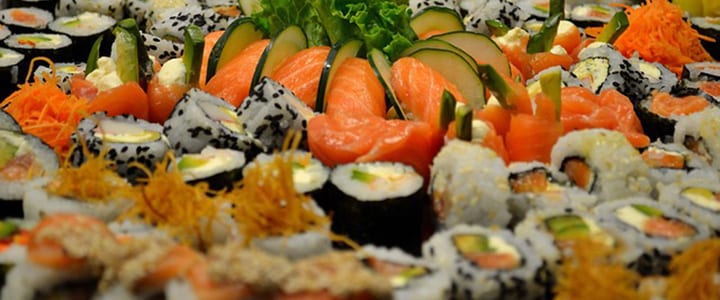There’s no better way to learn Japanese than exploring the culture and sampling some of the signature dishes! Sushi is one of the most popular Japanese foods, not only in Japan, but also worldwide.
Sushi has a long history in Asia, and the traditional Japanese cuisine is vastly different from the sushi you find in America, which brings us to etiquette. Learn proper dining manners, whether you’re a longtime sushi fan or just discovering this delicacy.
Sushi History
Sushi as we know it today is an edible art form. The itamae (sushi chef) uses the freshest ingredients: fish, rice, shoyu (soy sauce), wasabi (Japanese horseradish), and other seasoning, adds rice, and rolls it neatly in nori (seaweed). The presentation is just as appealing as the taste.
Sushi has a long history which dates back to second century A.D. in China. It was derived from a method to preserve fish; placing fish in rice would prevent it from going bad. The rice was later thrown away and the fish was eaten by itself.
Once this concept reached Japan, around seventh century A.D., the Japanese began eating this fish with the rice. Shortly thereafter, a man from Edo (Tokyo), Matsumoto Yoshiichi, began adding rice vinegar and selling this early version of sushi.
Sushi has gone through several upgrades since the early stages; here is an awesome look at its evolution.
Sushi Vocabulary
Now that you’re a sushi historian, it’s time to learn some important vocab. Here’s a list to get you started:
- Maki – Maki is a type of sushi rolled with a bamboo mat.
- Gunkan Nigiri – Gunkan means “boat.” The ingredients are held in place on top of the roll in a boat shape.
- Temaki – hand rolls. You can generally order sushi as a hand roll or a cut roll. Hand rolls are cone-shaped single servings, whereas cut rolls are smaller and easy to share.
- Nigiri – Sliced raw fish over rice. If you don’t like nori, you should try nigiri.
- Sashimi– Sliced raw fish (no rice).
- Chirashi – Assorted fish over rice, served in a bowl.
Sushi Ingredients
Some of the most popular sushi rolls are the California roll (crab, avocado, and cucumber), Philly roll (salmon, cream cheese, and vegetables), rainbow roll (crab, avocado, cucumber with tuna, yellowtail, and salmon on the outside), caterpillar roll (cucumber, fish cake, crab, avocado), and the dragon roll (cucumber, avocado, eel, and eel sauce).
One of the best things about going out to eat sushi is trying new things. Here are some of the common ingredients you will find on the sushi menu:
- Hamachi – Japanese amberjack (a type of yellowtail).
- Nori – Seaweed
- Tako – Octopus
- Tamago – Sweet egg
- Tobiko – Often used as a garnish, tobiko are flying fish roe (eggs)
- Unagi – Fresh-water eel.
- Wasabi – Be careful with this one, this spicy Japanese horseradish will add a kick to your roll.
- Shoyu – Soy Sauce
This is just a small sample of many ingredients you can add to sushi. Depending on how adventurous you feel, step out of your comfort zone and try ordering something new!
Sushi Etiquette
Impress your friends next time you dine out at a sushi restaurant with these guidelines:
Sushi Dos
- Eat what you take; wasting food is considered disrespectful. Plus, sushi is delicious!
- If you’re not great at using chopsticks, rest assured, you’re permitted to use your fingers to eat sushi. Keep in mind, however, this applies to hand rolls and cut rolls, you shouldn’t use your hands to eat sashimi.
- You should eat nigiri-style sushi in one bite.
- When you eat at a Japanese restaurant, you may hear a lot of slurping. Go ahead and join in, slurping noodles is OK!
Sushi Don’ts
- Sushi is generally served with ginger and wasabi. Don’t combine the ginger with your sushi; it should be used between bites to cleanse your palate.
- Don’t shake the shoyu off of your sushi.
- Dip your sushi fish side down. Only the fish (not the rice) is meant to be dipped in the shoyu.
- Only order sushi from the sushi chefs. You should order drinks, sides, appetizers, and additional items from your server.
- You may see people doing this all the time, but you’re not supposed to rub your chopsticks together.
5 Things You Didn’t Know About Sushi
- Most people think sushi means raw fish. This is a common misconception. Sushi actually means rice seasoned with vinegar, sugar, and salt.
- While many people eat Miso soup as an appetizer, in Japan, Miso soup is served at the end of the meal to aid digestion.
- The knives used by sushi chefs are direct descendants of samurai swords; the blades should be sharpened every day.
- You shouldn’t leave your chopsticks sticking up in your bowl. This symbolizes offering food for the dead.
- A sushi chef used to have to complete 10 years of training before he or she could work in a restaurant. Now, because of a much greater demand, a sushi chef can begin working after only two years of training.
Now that you’re a sushi expert, try some new items next time you grab sushi with your friends.
What are your favorite sushi rolls? Let us know in the comments below!
Share this Image On Your Site
Maile Proctor



